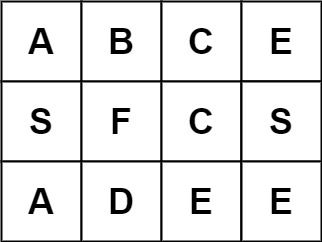79. Word Search

Description
Given an m x n grid of characters board and a string word, return true if word exists in the grid.
The word can be constructed from letters of sequentially adjacent cells, where adjacent cells are horizontally or vertically neighboring. The same letter cell may not be used more than once.
Example 1:

Input: board = [["A","B","C","E"],["S","F","C","S"],["A","D","E","E"]], word = "ABCCED" Output: true
Example 2:

Input: board = [["A","B","C","E"],["S","F","C","S"],["A","D","E","E"]], word = "SEE" Output: true
Example 3:

Input: board = [["A","B","C","E"],["S","F","C","S"],["A","D","E","E"]], word = "ABCB" Output: false
Constraints:
m == board.lengthn = board[i].length1 <= m, n <= 61 <= word.length <= 15boardandwordconsists of only lowercase and uppercase English letters.
Follow up: Could you use search pruning to make your solution faster with a larger board?
Solution
word-search.py
class Solution:
def exist(self, board: List[List[str]], word: str) -> bool:
rows, cols = len(board), len(board[0])
N = len(word)
visited = [[False] * cols for _ in range(rows)]
def go(x, y, index):
if index == N: return True
for dx, dy in [(x + 1, y), (x - 1, y), (x, y + 1), (x, y - 1)]:
if 0 <= dx < rows and 0 <= dy < cols and not visited[dx][dy] and board[dx][dy] == word[index]:
visited[dx][dy] = True
if go(dx, dy, index + 1): return True
visited[dx][dy] = False
return False
for i in range(rows):
for j in range(cols):
if board[i][j] == word[0]:
visited[i][j] = True
if go(i, j, 1): return True
visited[i][j] = False
return False